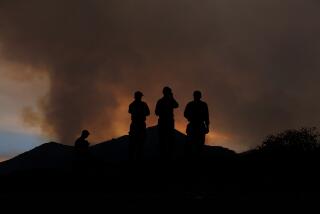Evacuation One of State’s Largest
- Share via
When up to 27,000 Southeast Los Angeles County residents fled a toxic gas cloud early Saturday morning, they unwittingly formed one of California’s largest-scale evacuations.
Yet officials attributed the large numbers not to the severity of the incident, but to the density of Los Angeles County.
As Northridge toxics expert Dr. John Douglas Arterberry explained, several fires at chemical plants in desert regions of Riverside County have created larger, more toxic clouds, but fewer people live nearby.
“One time we evacuated something like 100 square miles out there, but that was less than 100 people,” he said.
Triggers for mass evacuations include everything from gas leaks to earthquakes and from fires to bomb scares. But chemical contamination is by far the most common reason that Californians have been asked to leave their homes, avoid freeways and shun beaches.
Among Southern California’s largest evacuations:
An estimated 11,000 people from a 15-square-block area of Lincoln Heights were evacuated last May during a fire at a metal-plating company. Five schools in the area also were closed as was the USC School of Medicine.
During that incident, Dodger Stadium was turned into a shelter to handle the expected rush of evacuees, but a Red Cross spokeswoman said only 300 people showed up.
After the Whittier quake last Oct. 1, disaster officials estimated that 12,000 people had been forced from their homes. Two weeks after the temblor, 2,000 people still were living in shelters.
As pesticides continued to smolder for three days in 1985 after a fire at the Larry Fricker Co., a chemical warehouse in Anaheim, nearly 10,000 people were evacuated from nearby Anaheim, Fullerton and Placentia.
A hydrochloric acid spill at a Riverside bottled water plant in 1984 uprooted about 6,000 people and closed three schools.
More to Read
Sign up for Essential California
The most important California stories and recommendations in your inbox every morning.
You may occasionally receive promotional content from the Los Angeles Times.










